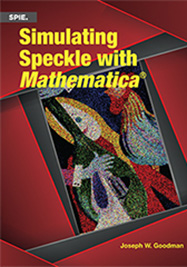|
|

Description
The speckle phenomenon is ubiquitous, occurring in all regions of the electromagnetic spectrum, as well as in both ultrasound and synthetic-aperture-radar imaging. Speckle occurs whenever radiation is reflected from a surface that is rough on the scale of a wavelength, or is passed through a diffusing surface that introduces random path-length delays on the scale of a wavelength. This book is devoted to simulation of speckle phenomena using the software package Mathematica®. Various techniques for simulating speckle are discussed. Simulation topics include first-order amplitude and intensity statistics, speckle phenomena in both imaging and free-space propagation, speckle at low light levels, polarization speckle, phase vortices in speckle, and speckle metrology methods. Contents 1 Introduction 1.1 Mathematica Background 1.2 Speckle Background 1.3 Methods for Simulating Speckle 2 First-Order Statistics of Speckle Amplitude 2.1 Speckle as a Sum of Independent Random Complex Phasors 2.2 Amplitude Statistics of the Sum of Many Random Phasors with Unit Lengths and Random Phases 2.3 Amplitude Statistics of the Sum of a Large Number of Unit-Length Random Phasors and One Large Phasor 2.4 Amplitude Statistics of the Sum of a Small Number of Unit-Length Random Phasors 3 First-Order Statistics of Speckle Intensity 3.1 Intensity Statistics of the Sum of Many Random Phasors with Unit Lengths and Random Phases 3.2 Intensity Statistics of the Sum of a Large Number of Unit-Length Random Phasors and One Large Phasor 3.3 Intensity Statistics of the Sum of a Small Number of Unit-Length Random Phasors 3.4 Intensity Statistics for Sums of Independent Speckle Patterns 3.5 Intensity Statistics of Partially Developed Speckle 4 Simulation of Speckle in Optical Imaging 4.1 Generation of a Discrete Diffuser Array with Correlated Phases 4.2 Speckle in an Imaging Geometry 4.3 The Autocorrelation Function of Speckle Intensity 4.4 The Power Spectrum of Speckle Intensity 4.5 Effect of Speckle on Resolution 4.6 Speckle in Color Images 5 Simulation of Speckle in Free-Space Propagation 5.1 The Diffuser 5.2 The Fresnel Transfer Function Approach 5.3 The Fresnel Transform Approach 6 Speckle at Low Light Levels 6.1 Photocount Image of a Uniform Intensity 6.2 The Negative-Binomial Distribution 6.3 Photocount Image for a Speckle Pattern with Uniform Statistics 6.4 Photocount Image for a Diffuse Structured Object 7 Speckle Phase Vortices 7.1 Generating the Speckle Pattern 7.2 Finding the Zeros of Intensity 7.3 Phase Behavior in the Vicinity of the Zeros of Intensity 8 Polarization Speckle 8.1 The Polarization Ellipse and the Degree of Polarization 8.2 Generating the Two Polarization Components 8.3 Generating a Filtered Speckle Pattern 8.4 Generating the Polarization Ellipses 8.5 Visualizing Polarization Speckle 9 Speckle Simulation for Metrology 9.1 Measurement of In-Plane Displacement 9.2 Electronic Speckle Pattern Interferometry 9.3 Phase-Shifting Speckle Interferometry Appendix A: Some Subtleties in Speckle Simulation With the 4f System A.1 Effects on the Speckle Contrast A.2 Simulation With a Smoothed Phase A.3 Simulation With an Unsmoothed Phase Appendix B: Some Subtleties in Dealing With Mathematica Images B.1 Dimensions of Data Arrays and Images B.2 Images When the Data Range Exceeds (0, 1) B.3 Effect of Using ImageAdjust[ ] on an Image B.4 Arrays With Bipolar Values B.5 Problem Encountered When Starting With an Image Acknowledgements References Related Topics Physics |
|
|
